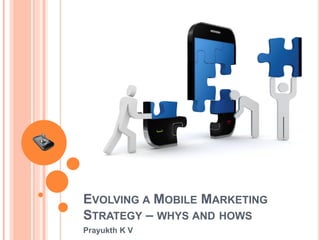
Evolving a mobile marketing strategy
- 1. EVOLVING A MOBILE MARKETING STRATEGY – WHYS AND HOWS Prayukth K V
- 2. THE FACTS Marketers are still struggling to understand the nuances of mobile marketing 2013 witnessed one of the largest jumps in mobile ad spend The average user looks at their mobile phone up to 150 times a day, according to Visual.ly; this makes mobile a vital channel to raise brand awareness The average penetration level of mobile broadband in developed countries is currently estimated at 75% for 2013, in developing countries at 20% Global mobile subscriptions are currently growing +7% YoY: Ericsson Many innovations in mobile – multi-SIM cards, low value rechargers, mobile payments – have originated in developing countries. “Shopping” on the mobile was a lower-order priority after socializing, playing, relaxing in the US in early 2013 The rise of “mobile only” homes in rising (40% in US, 20% in Australia) Mobile app revenue will reach $46 billion by 2016, up from about $8.5 billion in 2011: ABI Research Mobile accounted for almost 20% of online sales in November and December in the US.
- 4. GET THIS! Facebook controlled nearly 16 percent of the global mobile market in 2013 Facebook controlled nearly 16 percent of the global mobile market in 2013 Over 60 percent of Twitter's ad revenue will come from mobile advertising by 2015 Over 60 percent of Twitter's ad revenue will come from mobile advertising by 2015 Mobile Linkedin users are twice as active as desktop only users Mobile Linkedin users are twice as active as desktop only users Consumers look at native ads 25 percent more often than banner ads 57 percent of users wont recommend businesses with poor mobile sites
- 5. FROM DISCOVERY TO EXPERIENCE
- 6. COMPONENTS OF A MOBILE STRATEGY Mobile optimized website (response design included) Mobile applications Social media Mobile messaging Display ads Mobile content
- 7. STRATEGY - LOCATION Foursquare has built its entire business model on this idea. Revenue growth was 600% in 2013: CEO Dennis Crowley Popular means: geotargeting as a means of serving advertising and technologies like beacons, which send signals via Bluetooth to consumers' phones Services - from information on where to find a certain product in-store to smoother checkout. Challenge – consumers wary of sharing their location Strategy – create a strong value proposition to compel users to share their location Tactic - Allow your customers to interact and find great local incentives when they connect with your business on smartphones or tablets. Who should do this? Small businesses dependent on volume. Larger businesses can connect with consumers in a more personal way. Tip: Google discovered that almost half of women surveyed would share their location if offered a $5 store credit
- 8. STRATEGY: MESSAGING AND ADS Mobile traffic is rising 10 times faster than desktop traffic: Bright edge Engage audience where ever they are Popular means: Facebook ads, promoted tweets, sms and notifications Challenge – Getting the mix right (channels, segments and messages) Strategy – Ads don’t sell but information does Tactic - include graphics, rich media, and calls-to-action that are personalized to the greatest extent possible Who should do this? Small businesses that seek to improve brand visibility and target new segments. Larger businesses do not have a choice.
- 9. STRATEGY: SOCIAL MEDIA If you have imagination and budgets and know exactly what you want to get out of a social mobile tools. But before that try and answer these questions: What features will save time and take your social marketing to the next level? Do you have a unique need that is either under- served in the marketplace, or cost prohibitive?
- 10. STRATEGY: SOCIAL MEDIA Social media ‘humanizes’ your brand 81 percent of smartphone users check social media to read reviews before making a purchase: First Data Popular means: Facebook, Twitter, Hangouts… Services - from information on where to find a certain product in-store to smoother checkout. Challenge – consumers vary of sharing their location Strategy – Don’t connect unless you give them something to talk about Tactic - Marketers who have integrated their mobile programs with customer reviews and social media sharing buttons are enjoying the rewards; eg., Amazon. Who should do this? Ideally, everyone. But then as I said do you have the resources, stomach and imagination for this? If not, stick to emails. Tip: Try and see if you can do something on Instagram. The clue is “notification”
- 11. HOMEWORK Analyze customers: segment them based on location, age and other parameters to deliver a timely and relevant information Value: Amazon and Modcloth use mobile alerts to tell prospects when wish list items go on sale; send coupons via SMS Try seasonal engagement programs to regularly connect with your customers Cross pollinate: 35 percent of Super Bowl viewers completed a follow-up action on their mobile device based on a Super Bowl commercial on TV. QR codes: Use them if they deliver Harness data (sentiment and influence) to ease and automate marketing Have a separate website for mobile visitors For Twitter, use hashtags in moderation, leave space for user inputs in any tweet (facilitating user inputs in retweets) For Facebook: create valuable content and post at the right time (when target audience is active) Social media is about encouraging participation, remember that
- 12. REMEMBER Mobile device is the new desktop. Enable mobile as part of your online strategy to engage your audience on their mobile devices. Mobile represents a multi-channel experience for your audience Customers have been known to switch banks just to gain access to the mobile channel Call to action is not just desirable, but mandatory Always run pilot projects among employees to test new ideas
- 13. HAPPY MARKETING For more: in.linkedin.com/in/prayukthkv Figures culled from various data sources as of March 2014
